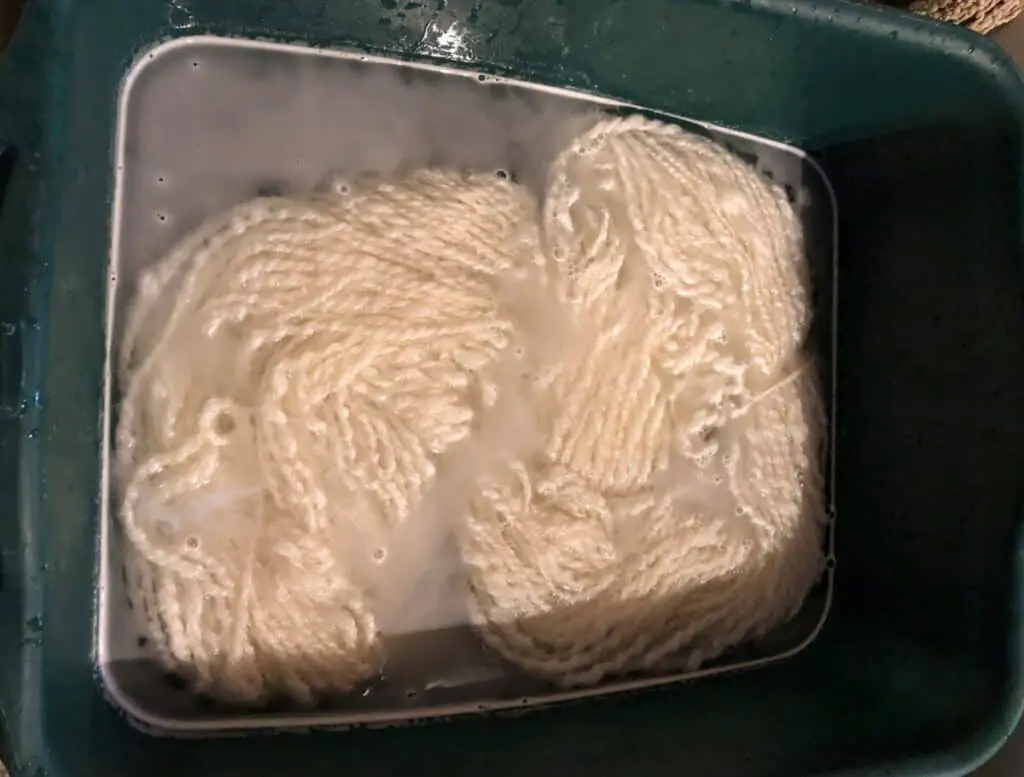Putting lanolin back into your wool garments or wool yarn is a great way to waterproof them. If you’re going to try to waterproof your wool this way, it’s good to know if you can overlanolize wool.
You can overlanolize wool by adding too much lanolin to your lanolin bath while waterproofing your wool. Too much lanolin will give your wool a sticky, greasy feeling. If you do overlanolize wool, you can wash the wool in hot water and soap to remove the excess lanolin.
In this post, we’ll discuss what lanolin actually is, why you want it on your wool, and how to remove excess lanolin from your wool. Let’s get cracking!
Table of Contents
What is Lanolin?

Lanolin, which translates as ‘wool oil’ from Latin, is a greasy substance produced by sheep. This substance is similar to the grease of human skin in that it helps keep the skin moisturized and soft.
However, lanolin is also water-resistant which makes the wool on the sheep water-resistant. This means that when a sheep is out on the pasture and they get rained on, the water will slip off the sheep instead of soaking their wool.
This is important for the same reason that we don’t want to wear wet socks all day. The constant wetness can cause various health problems in the sheep including skin rot.
Lanolin is also used in many different applications for humans. It is often added to industrial lubricants or oils that will be used in contact with water. It lubricates the machine while also protecting it from the rust-causing water.
In the health and beauty industry, it’s been added to moisturizing creams and chapsticks. It’s especially good at relieving dry skin around the nipples from breastfeeding.
One not-so-great thing about lanolin is that you can be allergic to it. This is often what some people mistake as being allergic to wool. It’s very rare to be allergic to clean wool but it’s much more common to be allergic to lanolin.
If you think you’re allergic to wool, or there are skin creams that cause you to break out and you can’t figure out why, check the ingredient list for lanolin. Because not many people know about lanolin, it’s often an allergy that can be overlooked and hard to diagnose.
Hopefully, you learned something new about lanolin today! Now let’s talk about why you might want lanolin in your wool.
Why Lanolize Your Wool?
As I mentioned in the previous section, lanolin is water-resistant and causes water to bead up and slip off the wool just like it does on your raincoat.
However, in order to process wool more easily, commercial wool mills scour the lanolin off the wool before it’s spun into yarn. This means that wool loses most of its water-resistant properties.
But, you can introduce lanolin back into your wool yarn or wool garment by washing it in a lanolin and soap mixture.
This will make your wool nearly waterproof which is great for winter clothes like hats and gloves. It also helps the wool last longer because it has the moisturizing and protective properties of lanolin.
If you’re interested in lanolizing your wool, check out my other post about waterproofing wool.
What To Do if You Overlanolize Wool

The process of lanolizing wool is pretty easy, but it can go wrong if you agitate the wool or add too much lanolin.
If you agitate the wool while it’s in the hot water, you will felt and shrink the wool.
If you add too much lanolin wax to the soap bath, you run the risk of overlanolizing your wool. This makes the wool gummy and sticky, no one wants that.
So, let’s go over what to do if you overlanolize your wool.
In commercial mills, they remove the natural lanolin from the wool so it doesn’t gum up their machines while they’re trying to process it. You can remove lanolin from a lanolizing mishap in the same way.
All you need is a tub of hot water, a scouring agent which can be either a soap specific to wool scouring or a liquid dish soap like Dawn, and your overlanolized wool.
Before you start the scouring process, you want to soak your overlanolized wool in hot water. Make sure when you put it in the hot water you only gently press it down into the water, never swirl it around, this will cause felting.
Let the wool soak for at least ten minutes to make sure the fibers are saturated. This makes it so the lanolin can be released from the wool fibers.
Now that your wool is thoroughly soaked, add a couple of drops of your chosen soap to a separate tub of hot water. If you have a large amount of wool yarn or a large garment, add a few more drops of soap.
Take your soaking wool out of its current hot bath and gently squeeze some of the excess water out, you might already see some of the lanolin coming off.
Now, press your wool down into the soapy tub. If the water is too hot to put your hands in just use a spoon or other kitchen utensil.
Then just let the wool soak. After a long soak, you can go back in and press the wool down into the water again, this will squish out some of the lanolin stuck in the fibers.
Depending on how much lanolin is on your wool, you may have to repeat this process a few times.
Once you’re satisfied with how much lanolin you’ve removed, rinse the wool in hot water, being just as gentle as you were before.
Lay the wool flat to dry. Once it’s dry, double-check to see if you need to wash it again. That’s the great thing about this process, you can just keep washing it until you’re happy.
Wrap up
We’ve been on quite the lanolin charged journey, but let’s look back to cover the main points.
Lanolin is a kind of grease made by wool sheep that helps waterproof their wool and keep their skin healthy.
It is used in many health and beauty products as well as some industrial applications.
You can wash wool in a lanolin and soap mixture to help waterproof it against the elements.
If you add too much lanolin to your waterproofing bath, you can overlanolize your wool. If this happens, wash the wool in a scouring agent until the wool is free of lanolin.
Whew, I got tired just thinking about all that wool washing. But, I hope this article helped you out of a sticky, or greasy, situation.
Now, go make something awesome!

